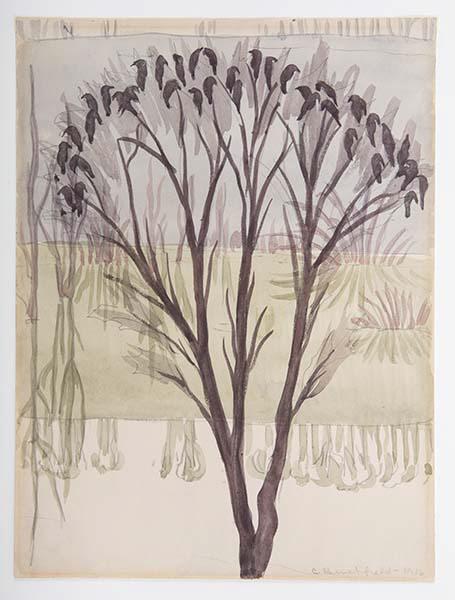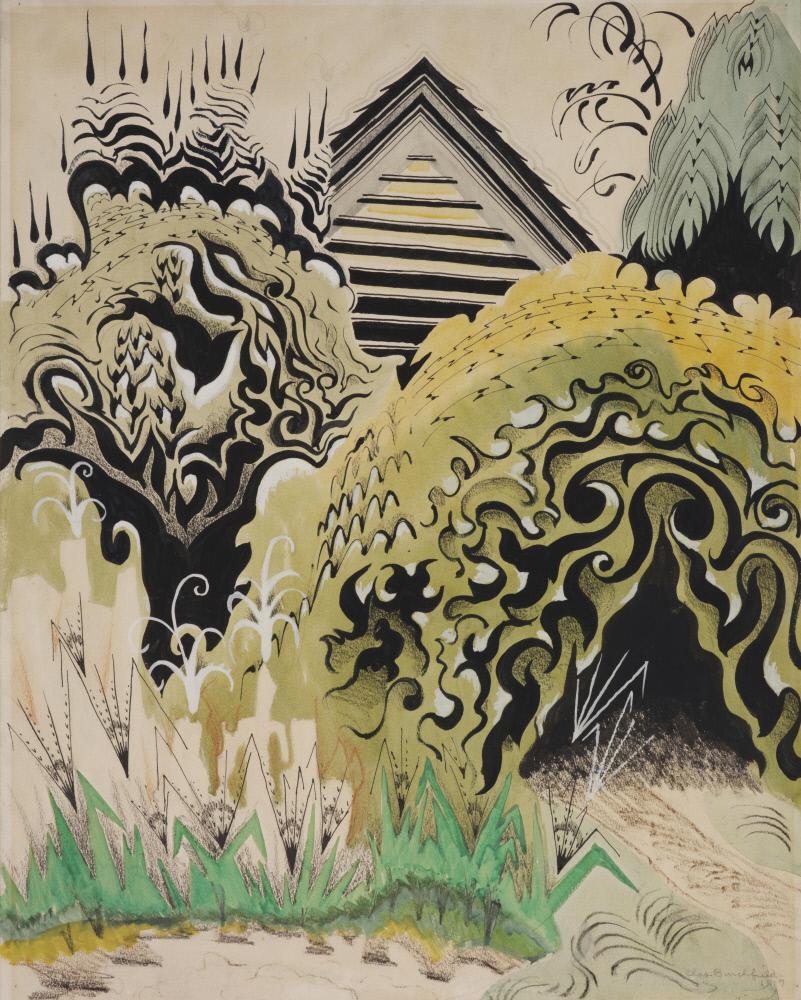Charles Burchfield
Charles Burchfield is an American artist known for his vivid and emotionally charged watercolors of American landscapes. Burchfield mostly painted scenes from the different towns in which he lived, the most significant of which where Buffalo, New York and Salem, Ohio. In regards to his early career and schooling, Burchfield attended the Cleveland School of Art from 1912-1916, where he would eventually master his uniquely beautiful way of capturing the image of the American township and nature. During his time at university the artist was exposed to Asian art, as well as the Japanese prints that would later wholly influence his decorative style and sensibility as a painter. 1917, the year after his graduation from the Cleveland School of Art, is often described as his “Golden Year.” During this time, he created “expressive compositions,” like The Insect Chorus, featured in the Munson-Williams-Proctor Institute’s collection. In the works from this period of his life, Burchfield wanted to use his memories and the many feelings he associated with his childhood to influence his compositions. Burchfield was transfixed with the possibility of creating almost sentimental representations of nature based on those same memories, and the works that followed are representative of the places he lived and experienced throughout his life, while also being full of the haziness and nostalgia that one would expect from a man reflecting on the past. The artist moved with his wife to Buffalo, New York in 1921, where he became intrigued by the scenery of the city, and transitioned into a more realistic style of painting. During the 1920s and 1930s, he was often associated with his friend and contemporary Edward Hopper, as both artists created works that evoked what their critics and viewerships often cited as similar feelings of loneliness. Naturally, however, in the 1940s Burchfield’s style would come to change, as he quickly saw himself abandoning realism in exchange for a return to a more personal and fantastical view of the natural world around him: the same sort of view that had influenced the style he employed during his “Golden Year”. Two of his early works, Blackbirds and The Insect Chorus, are strong examples of Burchfield’s imaginative, decorative, and expressive style.
Blackbirds, painted in 1916, and The Insect Chorus, painted in 1917, were both created during a period of Burchfield’s career during which he often created visual representations of the emotions surrounding some of his childhood memories. Both of these works are watercolors, and depict outdoor scenes. Similarly, both paintings have a strong decorative quality, likely inspired by Burchfield’s exposure to Asian art– and in particular Japanese prints, which he was introduced to during his time at the Cleveland School of Art. The artist’s works use expressive colors and distortion, which he achieved independently of the first examples of European modernism, which he would learn more about later in his life.

Blackbirds is a clear example of the influence that Japanese woodcuts had on Burchfield. This is reflected in his use of stylized forms, decorative patterning, and in a flattening of the picture plane. There is something very delicate in particular in this work, which differs from The Insect Chorus. Instead of the deep, black ink used in The Insect Chorus, there are light washes of black and brown, clearly done in watercolor. The work uses line and shape to define the tree in the center of the image, the work’s focal point. However, these lines are not harsh and rigid, rather, they are soft and flowing, created with careful application of watercolor. The work appears simplistic, yet in the background, lighter washes of color are visible, creating a shadow effect, and seems to represent the rest of the forest or natural scene behind the tree. Although the painting is abstract, the figures within the image are identifiable, such as the trees, and even the blackbirds sitting on the tree branches. However, the blackbirds almost also appear like leaves, which might be exactly what the tree looked like to Burchfield, so full of blackbirds that they were as plentiful as the leaves.This watercolor work used delicate and intentional brushstrokes and washes of color. The greens, greys, and browns are all reflective of the colors that Burchfield encountered in nature, and create a hazy atmosphere around the image, almost as though the scene is taking place at dusk, or during a rain shower. Further, Burchfield had a great understanding of nature, “…and was familiar with the essays and poetry on the subject by Henry David Thoreau, Ralph Waldo Emerson, and John Burroughs.” Not only was Burchfield influenced by his actual observations, but he was also inspired by writings on nature. Combined, these elements resulted in Burchfield’s dream-like representation of blackbirds in a tree.
Blackbirds was bequeathed to the Wellin Museum at Hamilton College by Daniel W. Deitrich II, Class of 1964. Deitrich also bequeathed Spring Rain by Burchfield to the Wellin Museum, which was also painted in 1916. Both of these works are delicate watercolors, with a dream-like representation of nature. Blackbirds and Spring Rain just precede Burchfield’s “Golden Year,” which includes his painting The Insect Chorus. This work is a much more dramatic representation of nature. Although still dream-like, this work is much more vivid. Instead of coming to the artist in a haze, the forms are clearly represented and defined through the use of line and shape. When comparing Blackbirds and The Insect Chorus, a clear evolution of Burchfield’s style is visible. Although he would later foray into realism, similar to that of his friend Edward Hopper, he would later return to this more abstract way of painting. Hopper commented on Burchfield’s work by saying, “The work of Charles Burchfield is most decidedly founded, not on art, but on life, and the life that he knows and loves best.” This brilliantly sums up the work of Charles Burchfield, as he creates beautiful renderings of his natural surroundings, many of which are influenced by memories, and uses these inspirations to shape the way he experiences and portrays nature.

The Insect Chorus was given to the Munson-Williams-Proctor Institute at the bequest of Edward Root. In a later letter to Edward and Grace Root, Burchfield described the works he created in 1917 along with The Insect Chorus: “In 1917 I made a collection of such ‘memories’ (childhood moods I called them) filling a note-book with them… Most adults spurn the things of their childhood and consider the yearning for such things in a grown man as a weakness.” Burchfield embraced his childhood memories and turned them into inspiration for his artwork. In The Insect Chorus, we can see what this image may have looked like through a child’s eyes. The large, distorted bushes, that do not appear entirely realistic, and also the manner in which it is difficult to tell where the bushes and shapes begin and where they end. This is representative of how a memory sometimes feels, it can be fuzzy, not entirely clear, especially a memory from childhood. Burchfield uses powerful contrasts between the richness of the ink and the washes of watercolor. This seems to heighten the intensity of the image, as does the use of sharp lines. There are sharp horizontal and vertical lines in the roof of the house in the background, but in the shapes representing bushes and trees, the lines are still very smooth, but they also twist and curve. This emphasizes how in nature, figures and shapes are not always perfectly linear, but they actually bend and curve, and look more natural, unlike the house in the background which is clearly man-made. Further, there is only a slight distinction between the foreground and background, which makes the work seem even more chaotic. The work situates the viewer in the foreground, and it feels like one is shrunken in comparison to the scene. The bushes and the house in the distance seem to loom over the grass in the foreground, making one feel as though they must look up to see the bushes and trees. In addition, it seems as though the house is hidden by the wildlife that has grown all around it, as though the house is in a densely wooded area. The Insect Chorus is a vibrant representation of Burchfield’s childhood memories, where his appreciation and understanding of the natural world is clearly apparent.
Burchfield is quoted as saying, “ ‘It is the romantic side of the real world that I portray…My things are poems—I hope.’” Blackbirds and The Insect Chorus represent a beautiful and expressive representation of nature. They are not just realistic depictions, but also idealized and romanticized ones. Burchfield uses elegant brushstrokes to convey the softness and beauty of nature, whilst the swaying of his forms are indicative of the haziness of memory. In both of these works, it is clear Burchfield has a deep understanding and respect for nature. These works were painted in two different years, 1916 and 1917 respectively, and show Burchfield’s own stylistic evolution. These works are from the beginning of Burchfield’s career, and it is powerful that he would return to paint in a similar abstract and fantastical style towards the end of his career. Clearly, works like The Insect Chorus and Blackbirds are indicative of Burchfield’s true style and essence.
Bibliography
“Artist to America.” Burchfield Penney Art Center., accessed September 26, 2019, https://www.burchfieldpenney.org/collection/charles-e-burchfield/biography/.
“Blackbirds.” Wellin Museum of Art., accessed September 25, 2019, http://wellin-emuseum.hamilton.edu/objects/7596/blackbirds?ctx=04e82acb-b0cc-41df-8d2c-7e8ae15ad7a7&idx=0.
Britannica Academic. s.v. “Charles Burchfiel.,” accessed September 30, 2019, https://academic.eb.com/levels/collegiate/article/Charles-Burchfield/18120.
“The Insect Chorus;” MWPAI Online Collections., accessed September 25, 2019, http://collections.mwpai.org/objects/11859/the-insect-chorus?ctx=31c4035c-d1ea-4963-b86f-2ed5773815a8&idx=0.
John, I. H. Baur. 1996. Burchfield, Charles Oxford University Press.